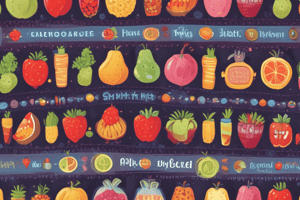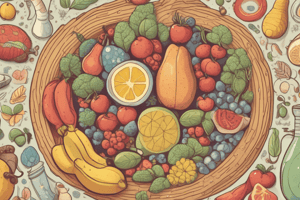Podcast
Questions and Answers
What is the glycemic index?
What is the glycemic index?
A scale that ranks carbohydrates by how much they raise blood glucose levels compared to a reference food.
What is the protocol for determining the glycemic index?
What is the protocol for determining the glycemic index?
- 25 or 50 grams carbohydrate of test food. 2. Blood samples taken at specific intervals. 3. Values plotted and AUC calculated. 4. Test food response compared to reference food response. 5. Average GI of 8-10 volunteers = GI of test food.
How is the glycemic index classified?
How is the glycemic index classified?
Low (0 – 55), Moderate (56 – 69), and High (70 or more)
What is the purpose of determining the glycemic index?
What is the purpose of determining the glycemic index?
What type of starch has a slower rate of digestion and a lower GI?
What type of starch has a slower rate of digestion and a lower GI?
Which food has a higher GI, Uncle Ben’s converted LG rice (50) or Russet potato (85)?
Which food has a higher GI, Uncle Ben’s converted LG rice (50) or Russet potato (85)?
How does bran influence the GI of foods?
How does bran influence the GI of foods?
Which type of fiber transforms intestinal contents into gel-like matter, slowing down enzymatic activity on starch?
Which type of fiber transforms intestinal contents into gel-like matter, slowing down enzymatic activity on starch?
What effect does fat and protein content have on the digestion of starch?
What effect does fat and protein content have on the digestion of starch?
How does acid content influence the GI of foods?
How does acid content influence the GI of foods?
What effect does food processing have on the GI of foods?
What effect does food processing have on the GI of foods?
How does cooking affect the GI of starch-containing foods?
How does cooking affect the GI of starch-containing foods?
What is the effect of all the factors mentioned on glycemic levels?
What is the effect of all the factors mentioned on glycemic levels?
How do the factors mentioned make us feel after eating carbohydrate-containing foods?
How do the factors mentioned make us feel after eating carbohydrate-containing foods?
Which type of rice has a higher GI, Uncle Ben’s converted LG rice (50) or Glutinous rice (98)?
Which type of rice has a higher GI, Uncle Ben’s converted LG rice (50) or Glutinous rice (98)?
What type of fiber is present in Apple (40) and Whole wheat bread (73) that contributes to their lower GI?
What type of fiber is present in Apple (40) and Whole wheat bread (73) that contributes to their lower GI?
Glycemic Index (GI) is a scale that ranks carbohydrates by how much they raise blood glucose levels compared to a reference food. A ______ GI is between 0 – 55.
Glycemic Index (GI) is a scale that ranks carbohydrates by how much they raise blood glucose levels compared to a reference food. A ______ GI is between 0 – 55.
The protocol for determining the glycemic index involves taking blood samples every 15 minutes in the 1st hour, every 30 minutes in the 2nd hour, and every 30 minutes for the 3rd hour for ______ volunteers only.
The protocol for determining the glycemic index involves taking blood samples every 15 minutes in the 1st hour, every 30 minutes in the 2nd hour, and every 30 minutes for the 3rd hour for ______ volunteers only.
The glycemic index is determined by comparing the test food response to the reference food response and calculating the AUC, which stands for Area Under the ______.
The glycemic index is determined by comparing the test food response to the reference food response and calculating the AUC, which stands for Area Under the ______.
The glycemic index is classified as ______, moderate, or high based on the range of values.
The glycemic index is classified as ______, moderate, or high based on the range of values.
Amylose absorbs ______ water
Amylose absorbs ______ water
Amylopectin absorbs ______ water
Amylopectin absorbs ______ water
Molecules form tight ______
Molecules form tight ______
Molecules are more ______
Molecules are more ______
Slower rate of ______
Slower rate of ______
Faster rate of ______
Faster rate of ______
Bran acts as a physical barrier that slows down enzymatic activity on the internal starch ______
Bran acts as a physical barrier that slows down enzymatic activity on the internal starch ______
Viscous, soluble fibers transform intestinal contents into ______-like matter that slows down enzymatic activity on starch
Viscous, soluble fibers transform intestinal contents into ______-like matter that slows down enzymatic activity on starch
Fat and protein slow down gastric emptying, and thus, slows down digestion of ______
Fat and protein slow down gastric emptying, and thus, slows down digestion of ______
Acid slows down gastric emptying, and thus, slows down the digestion of ______
Acid slows down gastric emptying, and thus, slows down the digestion of ______
Highly processed foods require less digestive ______
Highly processed foods require less digestive ______
Cooking swells starch molecules and softens foods, which speeds up the rate of ______
Cooking swells starch molecules and softens foods, which speeds up the rate of ______
Flashcards are hidden until you start studying




